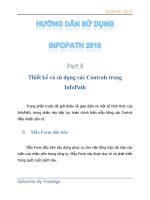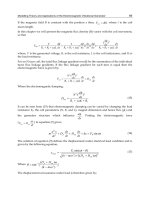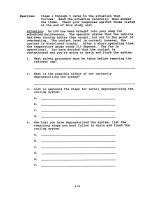Lubrication and Reliability Handbook 2010 Part 5 pptx
Bạn đang xem bản rút gọn của tài liệu. Xem và tải ngay bản đầy đủ của tài liệu tại đây (667.26 KB, 20 trang )
A19 Circulation systems
A19.3
Double-line systems
Double-line elements can be used in conjunction with a
reversing valve and piston or gear pump to lubricate
larger numbers of points spread over longer distances
geographically. These elements and their operation are
similar to those previously described under grease
systems.
Typical applications
Machine tools, textile plant, and special-purpose
machinery.
Simple low-pressure systems
The simple form illustrated uses a gear pump feeding the
points from connections from a main feed line through
needle valves with or without sight glasses.
Typical applications
Special-purpose machinery and machine tools.
Gravity-feed systems
Gravity-feed systems consist of a header tank, piped
through to one or more lubrication points. The level in
the header tank is maintained by a gear or other pump
with relief valve and filter mounted at the collection
tank.
This may be used as a back-up for a forced-feed system
where important bearings have a long run-down period
after removal of the power source, e.g. large air fans.
Figure 19.5
Figure 19.6
Figure 19.7
Figure 19.8
A19Circulation systems
A19.4
GROUP 2 SYSTEMS
The larger and usually more complex type of oil-circulatory system, used for both lubrication and cooling, falls into two
distinct classes. The first type, known as the self-contained system, is usually limited in size by the weights of the
components. For this reason the storage capacity of this type does not usually exceed 1000 gal. The second type covering
the larger systems has the main components laid out at floor level, e.g. in the oil cellar. The detailed design
considerations of the main components are discussed elsewhere, but in laying out the system the possible need for the
equipment in Table 19.1 should be considered.
Self-contained systems
Large oil-circulatory systems
The large oil-circulatory systems typical of those in use in steelworks, marine applications and power stations are
illustrated diagrammatically above.
Figure 19.9 A typical self-
contained oil-circulatory
system, incorporating a
200 gal tank. These types of
system may be used, if
required, with a pressure
vessel which would be
mounted as a separate unit
Figure 19.10
A19 Circulation systems
A19.5
CONTROL OF LUBRICANT QUANTITIES
The quantity fed to the lubrication point can be controlled in a number of ways; typical examples are shown below:
The output of a metering pump is itself adjustable by
some form of manual adjustment on each pump unit.
Sight glasses, of the rising or falling drop type, or of the
plug and taper tube type, are normally fitted.
The positive dividers may have sections which have
different outputs, and may be cross-drilled to connect
one or more outlets together to increase the quantity
available for each cycle.
Table 19.1 Main components of group 2 systems
Figure 19.11 Figure 19.12
A19Circulation systems
A19.6
Orifice plates may be used at the entry to the bearing or
gear system. The actual flow rates will vary with viscosity
unless knife-edge orifices are used, in which case the
viscosity variation is negligible.
Combined needle and sight flow indicators used for
adjusting small quantities of lubricant giving only a visual
indication of the flow of lubricant into the top of a
bearing.
With larger flow rates it may be adequate, with a
controlled pressure and oil temperature, simply to alter
the bore of the pipe through which the supply is taken.
The actual flow rates will vary with viscosity, and
pipework configuration, i.e. increased number of fittings
and directional changes.
The layout of a typical pressure control station is shown
above.
Figure 19.13 Typical flow ratios
Figure 19.14
Figure 19.15
A20 Design of oil tanks
A20.1
Table 20.1 Tank materials
Table 20.2 Tank components
A20Design of oil tanks
A20.2
Table 20.2 Tank components (continued)
A21 Selection of oil pumps
A21.1
Table 21.1 System factors affecting choice of pump type
Figure 21.1 Definition of pump heads
A21Selection of oil pumps
A21.2
Table 21.2 Comparison of the various types of pump
Gear pump
Spur gear relatively cheap, compact, simple in design.
Where quieter operation is necessary helical or double
helical pattern may be used. Both types capable of
handling dirty oil. Available to deliver up to about
0.02 m
2
/s (300 g.p.m.).
Lobe pump
Can handle oils of very viscous nature at reduced
speeds.
Screw pump
Quiet running, pulseless flow, capable of high suction
life, ideal for pumping low viscosity oils, can operate
continuously at high speeds over very long periods, low
power consumption. Adaptable to turbine drive. Avail-
able to deliver up to and above 0.075 m
3
/s
(1000 g.p.m.).
Vane pump
Compact, simple in design, high delivery pressure
capability, usually limited to systems which also perform
high pressure hydraulic duties.
Centrifugal pump
High rate of delivery at moderate pressure, can operate
with greatly restricted output, but protection against
overheating necessary with no-flow condition. Will
handle dirty oil.
A21 Selection of oil pumps
A21.3
Table 21.3 Pump performance factors affecting choice of pump type
Figure 21.2 Delivery against speed and viscosity
for a positive displacement pump
Figure 21.3 Pressure against delivery for positive
displacement and centrifugal pumps
Table 21.4 Selection by suction characteristics
A21Selection of oil pumps
A21.4
Table 21.5 Selection by head or pressure
Table 21.6 Selection by capacity
A22 Selection of filters and centrifuges
A22.1
Figure 22.1 Typical circuit showing positions of various filters
Table 22.1 Location and purpose of filter in
circuit
Table 22.2 Range of particle sizes which can be
removed by various filtration methods
A22Selection of filters and centrifuges
A22.2
PRESSURE FILTERS
Pressure filter specification and use
Figure 22.2 Various forms of woven wire mesh Figure 22.3 Typical filter efficiency curves
Figure 22.4 Typical full-flow pressure filter with integral bypass and pressure differential indicator
A22 Selection of filters and centrifuges
A22.3
In specifying the requirements of a filter in a particular
application the following points must be taken into
account:
1 Maximum acceptable particle size downstream of the
filter.
2 Allowable pressure drop across the filter.
3 Range of flow rates.
4 Range of operating temperatures.
5 Viscosity range of the fluid to be filtered.
6 Maximum working pressure.
7 Compatibility of the fluid, element and filter
materials.
In-line filtration
In many systems, the lubricating oil flows under pressure around a closed circuit, being drawn from and returned to a
reservoir. The same oil will then pass through the system continuously for long periods and effective filtration by one
of two approaches is possible, i.e. full-flow filtration and bypass filtration.
Full-flow filtration
A full-flow filter will handle the total flow in the circuit
and is situated downstream of the pump. All of the
lubricant is filtered during each circuit.
ADVANTAGE OF FULL FLOW
All particles down to specified level are removed.
Bypass filtration
In bypass filtration only a proportion of the oil passes
through the filter, the rest being bypassed unfiltered. In
theory, all of the oil will eventually be filtered but the
prevention of the passage of particles from reservoir to
bearings, via the bypass, cannot be guaranteed.
ADVANTAGES OF BYPASS
Small filter may be used. System not starved of oil under
cold (high viscosity) conditions. Lower pressure drop for
given level of particle retention. Filter cannot cut off
lubricant supply when completely choked.
Figure 22.5 Curve showing effect of temperature
on pressure drop when filtering lubricating oil
Figure 22.6 Simplified circuit of full-flow filter
Figure 22.7 Simplified circuit of bypass filter
A22Selection of filters and centrifuges
A22.4
CENTRIFUGAL SEPARATION
Throughput specification
Selection of a centrifugal separator of appropriate
throughput will depend on the type of oil and the system
employed. A typical unit of nominal 3000 l/h (660 gal/h)
should be used at the following throughput levels:
Operating throughputs of other units may be scaled in
proportion.
Recommended separating temperatures
Straight mineral oils, 75°C (165°F).
Detergent-type oils, 80°C (175°F).
Fresh-water washing
Water washing of oil in a centrifuge is sometimes
advantageous, the following criteria to be used to
determine the hot fresh-water requirement:
A23 Selection of heaters and coolers
A23.1
Lubricating oil heaters and coolers are available in many different forms. The most common type uses steam or water
for heating or cooling the oil, and consists of a stack of tubes fitted inside a tubular shell. This section gives guidance
on the selection of units of this type.
LUBRICATING OIL HEATERS
The required size of the heater and the materials of
construction are influenced by factors such as:
Lubricating oil circulation rate.
Lubricating oil pressure and grade or viscosity.
Maximum allowable pressure drop across the heater.
Inlet lubricating oil temperature to heater.
Outlet lubricating oil temperature from heater.
Heating medium, steam or hot water.
Inlet pressure of the steam or hot water to the
heater.
Inlet steam or hot water temperature.
Guidance on size of heat transfer surface
required
The graph shows how the required heat transfer surface
area varies with the heat flow rate and the oil velocity, for
a typical industrial steam heated lubricating oil heater,
and is based on:
Heating medium Dry saturated steam at
700 kN/m
2
(100 p.s.i.)
Oil velocity Not exceeding 1 m/s
Oil viscosity SAE 30
Oil inlet temperature 20°C
Oil outlet temperature 70°C
Figure 23.1 Cross-section through a typical oil heater
Table 23.1 Guidance on materials of construction
Figure 23.2 Guide to the heating surface area for a
desired rate of heat input to oil flowing at various
velocities
A23Selection of heaters and coolers
A23.2
LUBRICATING OIL COOLERS
The required size of cooler and the materials of
construction are influenced by factors such as:
Lubricating oil circulation rate.
Lubricating oil pressure and grade or viscosity.
Maximum allowable pressure drop across the cooler.
Inlet lubricating oil temperature to cooler.
Outlet lubricating oil temperature from cooler.
Cooling medium (sea water, river water, town water,
etc.)
Cooling medium pressure.
Cooling medium inlet temperature to cooler.
Cooling medium circulation rate available.
Figure 23.3 Sectional view of a typical oil cooler
Table 23.2 Guidance on materials of construction
A23 Selection of heaters and coolers
A23.3
Guidance on the size of cooling surface area
required
The graph shows how the cooling area required varies
with the heat dissipation required, and the cooling water
temperature for typical lubricating oil system conditions
of:
Oil velocity 0.7 m/s
Oil viscosity SAE 30
Water velocity 1 m/s
Oil inlet temperature 70°C
Oil outlet temperature 60°C
Table 23.3 Choice of tube materials for use with
various types of cooling water
Figure 23.4 Guide to the cooling surface area
required for a desired dissipation rate at various
cooling water temperatures
A24A guide to piping design
A24.1
Figure 24.1 Typical lubrication system
Table 24.1 Selection of pipe materials
A24 A guide to piping design
A24.2
Table 24.2 Selection of control valves
A24A guide to piping design
A24.3
Table 24.3 Pipe sizes and pressure-drop calculations









